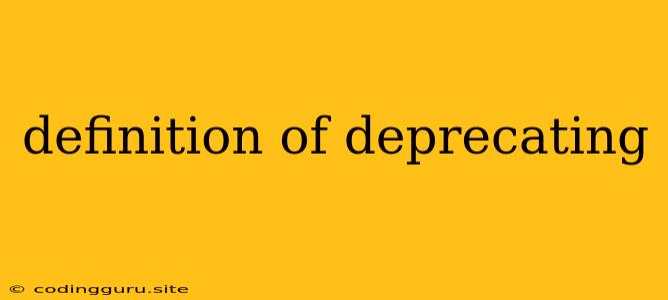What Does It Mean When Something is Deprecated?
In the world of software development, you might come across the term "deprecated" and wonder what it implies. While it sounds a bit like something someone might say to a grumpy cat, it actually holds a specific meaning within the realm of programming and technology.
Deprecation is a process of marking a feature, function, or technology as outdated and suggesting alternatives. It's like a gentle nudge from the developers, saying, "Hey, we've got something better, maybe you should start using that instead."
But why is something deprecated? The reasons can vary:
- Security Concerns: An old function might have vulnerabilities that can be exploited by hackers.
- Efficiency: New technologies often offer more efficient ways to achieve the same result.
- Maintenance Burden: Keeping old features up-to-date can be a heavy lift for developers, so they might choose to focus on newer, more streamlined solutions.
- Lack of Support: As time passes, the developers might decide to stop supporting the older feature entirely, leading to potential issues for users who continue to rely on it.
Why Is This Important?
Understanding deprecation is crucial for developers and users alike. For developers, it means staying informed about the latest practices and adopting new tools. For users, it means being aware of potential compatibility issues and making necessary changes to their workflows.
Here's a simple analogy: Imagine you have an old, clunky cell phone. While it still makes calls, it lacks modern features like apps, high-quality cameras, and internet connectivity. A new phone offers all these advantages, but it means switching away from the old one.
Deprecation works in much the same way: Developers may provide an updated "phone" with better features, encouraging users to switch over.
Deprecation in Action: Real-World Examples
- HTML5: The adoption of HTML5 led to the deprecation of older HTML versions, like HTML4. This move brought improved features, better accessibility, and a more streamlined web development experience.
- JavaScript Libraries: Libraries like jQuery, which were once staples in web development, have seen their importance diminish due to the increasing capabilities of vanilla JavaScript. This has led to a shift towards modern frameworks and libraries like React, Vue.js, and Angular.
- APIs: Web APIs often go through version updates, and older versions may be deprecated to encourage developers to adopt new features and security enhancements.
What Happens When Something is Deprecated?
- Warning Messages: You might encounter warnings in your code editor or in the console logs, letting you know that you're using a deprecated feature.
- Reduced Support: The developers may offer limited support for the deprecated feature. This means bug fixes or improvements may be less frequent.
- Potential Removal: In the future, the deprecated feature may be entirely removed from the software or platform.
Tips for Dealing with Deprecation
- Stay Informed: Read documentation and release notes to stay updated on any deprecations.
- Plan Ahead: If a feature you rely on is deprecated, plan to switch to the recommended alternative before it is removed.
- Utilize Warnings: Treat deprecation warnings as opportunities to upgrade your code and take advantage of newer features.
- Seek Assistance: If you encounter challenges migrating away from a deprecated feature, don't hesitate to seek help from developer communities or documentation.
Conclusion
Deprecation is an essential part of technological advancement. It allows for progress, ensures security, and promotes efficiency. By understanding the concept of deprecation and adopting best practices, you can keep your projects up-to-date and avoid potential issues down the line. Remember, the journey of software development is constantly evolving, and embracing new technologies and deprecating outdated ones is a natural part of the process.
